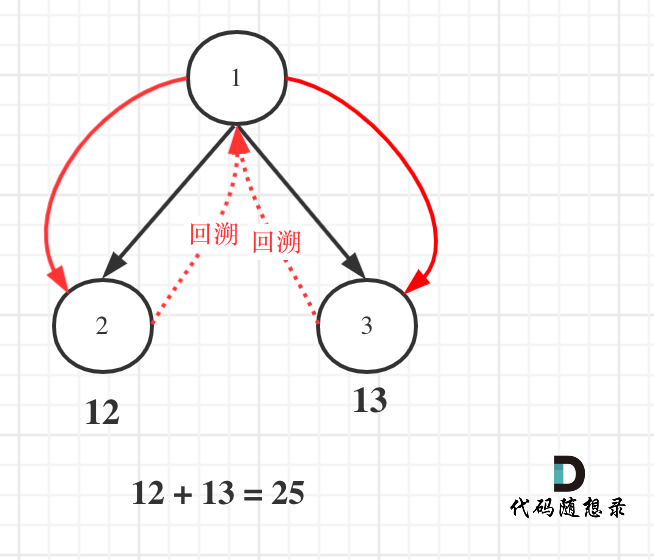参与本项目,贡献其他语言版本的代码,拥抱开源,让更多学习算法的小伙伴们收益!
本题和113.路径总和II是类似的思路,做完这道题,可以顺便把113.路径总和II 和 112.路径总和 做了。
结合112.路径总和 和 113.路径总和II,我在讲了二叉树:递归函数究竟什么时候需要返回值,什么时候不要返回值?,如果大家对二叉树递归函数什么时候需要返回值很迷茫,可以看一下。
接下来在看本题,就简单多了,本题其实需要使用回溯,但一些同学可能都不知道自己用了回溯,在二叉树:以为使用了递归,其实还隐藏着回溯中,我详细讲解了二叉树的递归中,如何使用了回溯。
接下来我们来看题:
首先思路很明确,就是要遍历整个树把更节点到叶子节点组成的数字相加。
那么先按递归三部曲来分析:
如果对递归三部曲不了解的话,可以看这里:二叉树:前中后递归详解
- 确定递归函数返回值及其参数
这里我们要遍历整个二叉树,且需要要返回值做逻辑处理,所有返回值为void,在二叉树:递归函数究竟什么时候需要返回值,什么时候不要返回值?中,详细讲解了返回值问题。
参数只需要把根节点传入,此时还需要定义两个全局遍历,一个是result,记录最终结果,一个是vector path。
为什么用vector类型(就是数组)呢? 因为用vector方便我们做回溯!
所以代码如下:
int result;
vector<int> path;
void traversal(TreeNode* cur)
- 确定终止条件
递归什么时候终止呢?
当然是遇到叶子节点,此时要收集结果了,通知返回本层递归,因为单条路径的结果使用vector,我们需要一个函数vectorToInt把vector转成int。
终止条件代码如下:
if (!cur->left && !cur->right) { // 遇到了叶子节点
result += vectorToInt(path);
return;
}
这里vectorToInt函数就是把数组转成int,代码如下:
int vectorToInt(const vector<int>& vec) {
int sum = 0;
for (int i = 0; i < vec.size(); i++) {
sum = sum * 10 + vec[i];
}
return sum;
}- 确定递归单层逻辑
本题其实采用前中后序都不无所谓, 因为也没有中间几点的处理逻辑。
这里主要是当左节点不为空,path收集路径,并递归左孩子,右节点同理。
但别忘了回溯。
如图:
代码如下:
// 中
if (cur->left) { // 左 (空节点不遍历)
path.push_back(cur->left->val);
traversal(cur->left); // 递归
path.pop_back(); // 回溯
}
if (cur->right) { // 右 (空节点不遍历)
path.push_back(cur->right->val);
traversal(cur->right); // 递归
path.pop_back(); // 回溯
}这里要注意回溯和递归要永远在一起,一个递归,对应一个回溯,是一对一的关系,有的同学写成如下代码:
if (cur->left) { // 左 (空节点不遍历)
path.push_back(cur->left->val);
traversal(cur->left); // 递归
}
if (cur->right) { // 右 (空节点不遍历)
path.push_back(cur->right->val);
traversal(cur->right); // 递归
}
path.pop_back(); // 回溯把回溯放在花括号外面了,世界上最遥远的距离,是你在花括号里,而我在花括号外! 这就不对了。
整体C++代码
关键逻辑分析完了,整体C++代码如下:
class Solution {
private:
int result;
vector<int> path;
// 把vector转化为int
int vectorToInt(const vector<int>& vec) {
int sum = 0;
for (int i = 0; i < vec.size(); i++) {
sum = sum * 10 + vec[i];
}
return sum;
}
void traversal(TreeNode* cur) {
if (!cur->left && !cur->right) { // 遇到了叶子节点
result += vectorToInt(path);
return;
}
if (cur->left) { // 左 (空节点不遍历)
path.push_back(cur->left->val); // 处理节点
traversal(cur->left); // 递归
path.pop_back(); // 回溯,撤销
}
if (cur->right) { // 右 (空节点不遍历)
path.push_back(cur->right->val); // 处理节点
traversal(cur->right); // 递归
path.pop_back(); // 回溯,撤销
}
return ;
}
public:
int sumNumbers(TreeNode* root) {
path.clear();
if (root == nullptr) return 0;
path.push_back(root->val);
traversal(root);
return result;
}
};过于简洁的代码,很容易让初学者忽视了本题中回溯的精髓,甚至作者本身都没有想清楚自己用了回溯。
我这里提供的代码把整个回溯过程充分体现出来,希望可以帮助大家看的明明白白!
class Solution {
List<Integer> path = new ArrayList<>();
int res = 0;
public int sumNumbers(TreeNode root) {
// 如果节点为0,那么就返回0
if (root == null) return 0;
// 首先将根节点放到集合中
path.add(root.val);
// 开始递归
recur(root);
return res;
}
public void recur(TreeNode root){
if (root.left == null && root.right == null) {
// 当是叶子节点的时候,开始处理
res += listToInt(path);
return;
}
if (root.left != null){
// 注意有回溯
path.add(root.left.val);
recur(root.left);
path.remove(path.size() - 1);
}
if (root.right != null){
// 注意有回溯
path.add(root.right.val);
recur(root.right);
path.remove(path.size() - 1);
}
return;
}
public int listToInt(List<Integer> path){
int sum = 0;
for (Integer num:path){
// sum * 10 表示进位
sum = sum * 10 + num;
}
return sum;
}
}class Solution:
def sumNumbers(self, root: TreeNode) -> int:
res = 0
path = []
def backtrace(root):
nonlocal res
if not root: return # 节点空则返回
path.append(root.val)
if not root.left and not root.right: # 遇到了叶子节点
res += get_sum(path)
if root.left: # 左子树不空
backtrace(root.left)
if root.right: # 右子树不空
backtrace(root.right)
path.pop()
def get_sum(arr):
s = 0
for i in range(len(arr)):
s = s * 10 + arr[i]
return s
backtrace(root)
return resfunc sumNumbers(root *TreeNode) int {
sum := 0
dfs(root, root.Val, &sum)
return sum
}
func dfs(root *TreeNode, tmpSum int, sum *int) {
if root.Left == nil && root.Right == nil {
*sum += tmpSum
} else {
if root.Left != nil {
dfs(root.Left, tmpSum*10 + root.Left.Val, sum)
}
if root.Right != nil {
dfs(root.Right, tmpSum*10 + root.Right.Val, sum)
}
}
}var sumNumbers = function(root) {
const listToInt = path => {
let sum = 0;
for(let num of path){
// sum * 10 表示进位
sum = sum * 10 + num;
}
return sum;
}
const recur = root =>{
if (root.left == null && root.right == null) {
// 当是叶子节点的时候,开始处理
res += listToInt(path);
return;
}
if (root.left != null){
// 注意有回溯
path.push(root.left.val);
recur(root.left);
path.pop();
}
if (root.right != null){
// 注意有回溯
path.push(root.right.val);
recur(root.right);
path.pop();
}
return;
};
const path = new Array();
let res = 0;
// 如果节点为0,那么就返回0
if (root == null) return 0;
// 首先将根节点放到集合中
path.push(root.val);
// 开始递归
recur(root);
return res;
};function sumNumbers(root: TreeNode | null): number {
if (root === null) return 0;
// 记录最终结果
let resTotal: number = 0;
// 记录路径中遇到的节点值
const route: number[] = [];
// 递归初始值
route.push(root.val);
recur(root, route);
return resTotal;
function recur(node: TreeNode, route: number[]): void {
if (node.left === null && node.right === null) {
resTotal += listToSum(route);
return;
}
if (node.left !== null) {
route.push(node.left.val);
recur(node.left, route);
route.pop();
};
if (node.right !== null) {
route.push(node.right.val);
recur(node.right, route);
route.pop();
};
}
function listToSum(nums: number[]): number {
// 数组求和
return Number(nums.join(''));
}
};//sum记录总和
int sum;
void traverse(struct TreeNode *node, int val) {
//更新val为根节点到当前节点的和
val = val * 10 + node->val;
//若当前节点为叶子节点,记录val
if(!node->left && !node->right) {
sum+=val;
return;
}
//若有左/右节点,遍历左/右节点
if(node->left)
traverse(node->left, val);
if(node->right)
traverse(node->right, val);
}
int sumNumbers(struct TreeNode* root){
sum = 0;
traverse(root, 0);
return sum;
}

